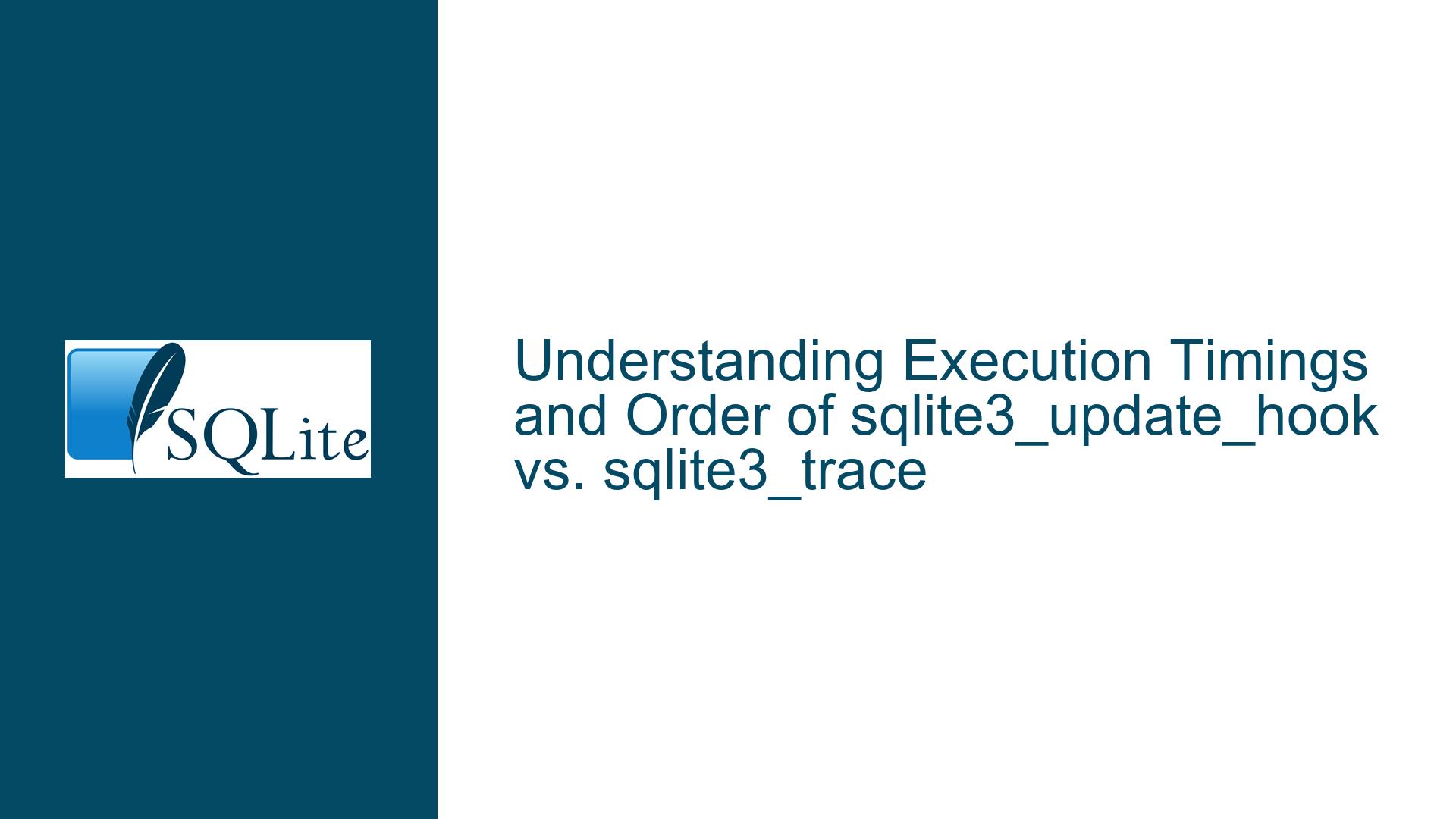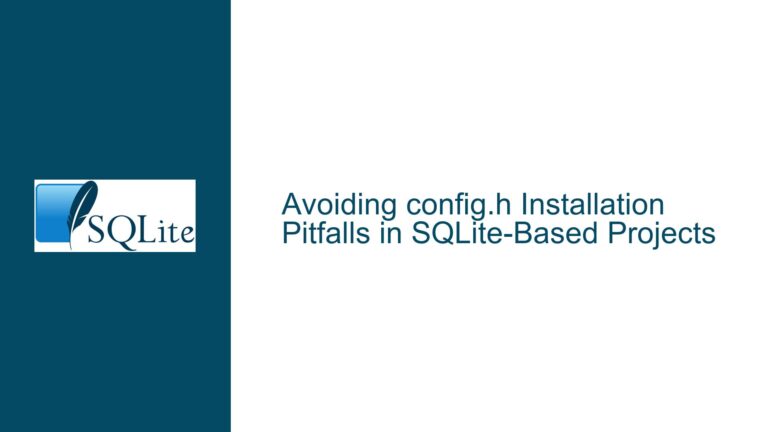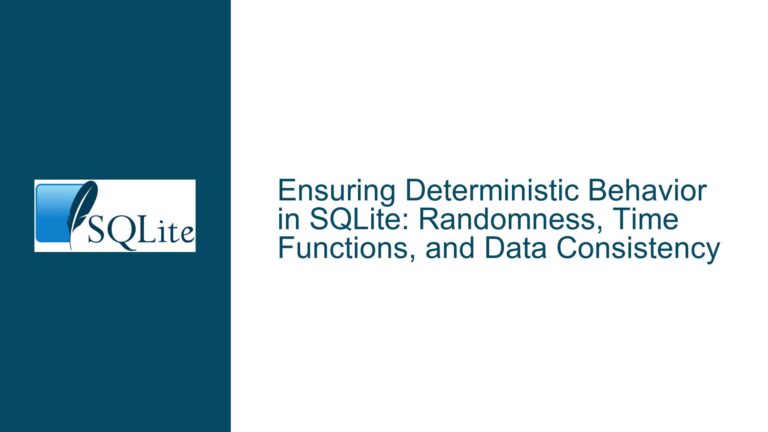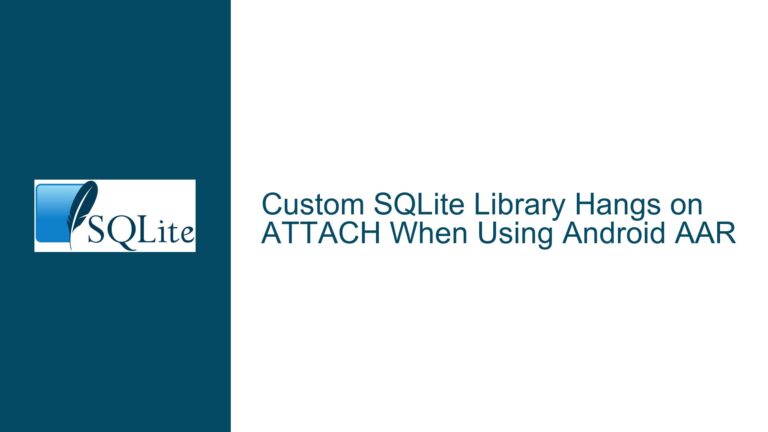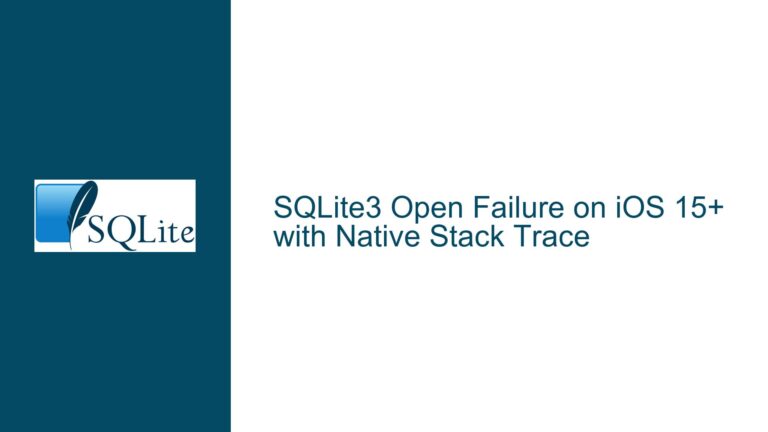Execution Timings and Order of sqlite3_update_hook vs. sqlite3_trace
Core Behavioral Differences Between sqlite3_update_hook and sqlite3_trace
This guide explores the nuanced differences in execution timing and sequence between SQLite’s sqlite3_update_hook and sqlite3_trace APIs. These mechanisms are critical for monitoring database activity but operate under distinct conditions that developers must understand to avoid unexpected behavior in applications.
Behavioral Characteristics of Update Hooks and Trace Functions
sqlite3_update_hook: Post-Operation Notification Mechanism
The sqlite3_update_hook is a callback mechanism designed to notify an application when a row in the database is modified via INSERT, UPDATE, or DELETE operations. The callback is registered once per database connection using sqlite3_update_hook(db, callback, user_data). When a modification occurs, the callback is invoked with arguments specifying the operation type, database name, table name, and the rowid of the affected row.
A critical aspect of sqlite3_update_hook is that its invocation timing relative to the actual database modification is unspecified. The SQLite documentation explicitly states that the order in which the update hook is called relative to other operations (including trace functions) is not guaranteed. However, based on the API design and implementation details, the update hook is typically triggered after the modification has been applied to the database. This is inferred from the callback’s void return type: if the hook were called before the operation, it might return an error code to abort the operation, but since it returns nothing, the operation is assumed to have already completed.
sqlite3_trace: SQL Statement Execution Monitoring
The sqlite3_trace function enables developers to monitor SQL statements as they are executed. This function registers a callback that is invoked at various stages of SQL processing. The trace callback can fire:
- When an SQL statement begins execution,
- After each step in the execution process (e.g., during
SELECTqueries with multiple result rows), - When the statement completes execution.
The timing of trace callbacks depends on the type of SQL operation. For example, a CREATE TABLE statement will trigger the trace callback once when the statement starts and once when it finishes. A SELECT query with 100 rows will trigger the trace callback at the start, after each row is fetched, and at the end.
Unlike the update hook, the trace function is directly tied to the execution phases of SQL statements. This makes it a lower-level tool for observing the internal workflow of SQLite, including parsing, optimization, and execution.
Key Interaction: Order of Execution Between Hooks
The central ambiguity lies in determining whether sqlite3_update_hook fires before or after sqlite3_trace during a database operation. For instance, if an INSERT statement is executed, does the trace callback for the statement’s completion occur before or after the update hook notifies the application of the row insertion?
The SQLite documentation clarifies that the relative order of these two callbacks is undefined. This means that across different SQLite versions, configurations, or even the same environment, the sequence may vary. Applications relying on a specific order between trace and update hooks are inherently fragile and should avoid such dependencies.
Root Causes of Ambiguity in Hook Execution Order
1. Asynchronous Nature of SQLite’s Operational Pipeline
SQLite processes SQL statements in multiple stages: parsing, preparation, execution, and finalization. The sqlite3_trace callback is deeply integrated into this pipeline, providing visibility into each stage. In contrast, sqlite3_update_hook is a higher-level mechanism that responds to completed modifications.
However, SQLite’s architecture allows for optimizations such as statement caching and write-ahead logging (WAL) that can decouple the logical execution of a statement from its physical application to the database. For example, in WAL mode, modifications are written to a log before being applied to the main database. This can create scenarios where the update hook is delayed relative to the trace callback, depending on when the transaction is committed.
2. Lack of Synchronization Guarantees in API Design
The SQLite C API does not enforce synchronization between hooks. The update hook and trace function are independent callbacks with no built-in mechanism to coordinate their execution order. This design choice reflects SQLite’s philosophy of minimizing overhead for features that most applications do not require.
For instance, consider an UPDATE statement that modifies 10 rows. The trace callback might fire once when the statement starts, 10 times during row updates, and once when the statement finishes. The update hook, however, will fire 10 times—once per row modification. The exact interleaving of these 10 update hook calls with the 12 trace callbacks is undefined.
3. Transaction Boundaries and Implicit Commit Behavior
Transactions further complicate the timing of hooks. If a statement is executed within an explicit transaction (e.g., BEGIN…COMMIT), the update hook may not fire until the transaction is committed. The trace callback, however, will report the statement’s execution as soon as it is processed by SQLite, regardless of whether the transaction is committed or rolled back later.
This discrepancy arises because the update hook reflects durable changes to the database, whereas the trace function reflects execution of SQL commands, which may or may not be finalized in the database depending on transaction outcomes.
4. Concurrency and Reentrancy Limitations
SQLite’s threading model and reentrancy rules impose additional constraints. For example, during an update hook callback, the application is not permitted to execute queries on the same database connection. This restriction prevents recursive modifications but also means that the update hook cannot inspect the database state as part of its operation.
The trace function, however, has no such restrictions. An application could theoretically execute additional SQL statements within a trace callback, though this is generally discouraged due to the risk of infinite loops or deadlocks.
Resolving Ambiguities and Implementing Reliable Hook Logic
1. Empirical Determination of Hook Execution Order
To observe the actual behavior of sqlite3_update_hook and sqlite3_trace in a specific environment, developers can write a test program that triggers both hooks and logs their execution order.
Example Test Code:
#include <sqlite3.h>
#include <stdio.h>
void trace_callback(void *user_data, const char *sql) {
printf("TRACE: %s\n", sql);
}
void update_hook_callback(void *user_data, int op_type, const char *db_name, const char *table_name, sqlite3_int64 rowid) {
const char *op = (op_type == SQLITE_INSERT) ? "INSERT" :
(op_type == SQLITE_UPDATE) ? "UPDATE" : "DELETE";
printf("UPDATE_HOOK: %s on %s.%s (rowid=%lld)\n", op, db_name, table_name, rowid);
}
int main() {
sqlite3 *db;
sqlite3_open(":memory:", &db);
// Register hooks
sqlite3_trace(db, trace_callback, NULL);
sqlite3_update_hook(db, update_hook_callback, NULL);
// Execute a sample SQL statement
sqlite3_exec(db, "CREATE TABLE test (id INTEGER PRIMARY KEY, value TEXT);", NULL, NULL, NULL);
sqlite3_exec(db, "INSERT INTO test (value) VALUES ('demo');", NULL, NULL, NULL);
sqlite3_close(db);
return 0;
}
Expected Output Analysis:
Running this code may yield different results across SQLite versions or platforms. A typical output might show:
TRACE: CREATE TABLE test (id INTEGER PRIMARY KEY, value TEXT);
TRACE: INSERT INTO test (value) VALUES ('demo');
UPDATE_HOOK: INSERT on main.test (rowid=1)
This suggests that the trace callback for the INSERT statement completed before the update hook fired. However, this order is not guaranteed.
2. Designing Applications to Accommodate Unspecified Order
Applications must avoid assuming a specific execution sequence between these hooks. Strategies include:
- Decoupling Logic: Isolate the functionality of the update hook and trace callback so they do not depend on each other’s data or timing.
- State Tracking: Use global variables or context objects to track the progression of operations independently in each hook.
- Synchronization Barriers: Implement manual synchronization (e.g., mutexes) if cross-hook coordination is unavoidable, though this introduces complexity and potential performance penalties.
3. Leveraging Alternative Mechanisms for Deterministic Timing
When precise timing is required, consider alternatives:
- SQLite Triggers: Use
BEFORE INSERTorAFTER UPDATEtriggers to enforce logic at specific points in the modification pipeline. Unlike hooks, triggers execute as part of the SQL statement and have well-defined timing relative to the operation. - Virtual Tables: Implement a virtual table that intercepts modifications at the storage layer, providing fine-grained control over notification timing.
- Prepared Statement Hooks: Use
sqlite3_preupdate_hookto register callbacks that fire before a row is modified, offering a deterministic point to inspect or alter changes.
4. Best Practices for Debugging Hook-Related Issues
- Logging: Augment hooks with detailed logging, including timestamps and thread IDs, to capture non-deterministic behavior.
- Minimal Callback Overhead: Ensure hooks execute quickly to avoid altering the natural timing of operations during debugging.
- Concurrency Testing: Stress-test applications under multi-threaded or high-load conditions to uncover race conditions exacerbated by hook timing ambiguities.
5. Addressing the “Database Locked” Limitation
A critical restriction of sqlite3_update_hook is that the callback cannot execute SQL statements on the same database connection. Attempting to do so will result in an SQLITE_LOCKED error. Workarounds include:
- Deferred Processing: Queue the required operations and execute them later, outside the hook context.
- Alternative Connections: Use a separate database connection (in multi-threaded mode) to perform queries triggered by the update hook.
By understanding the behavioral differences, root causes of ambiguity, and mitigation strategies outlined here, developers can effectively utilize sqlite3_update_hook and sqlite3_trace while avoiding pitfalls related to their execution timing and order.
